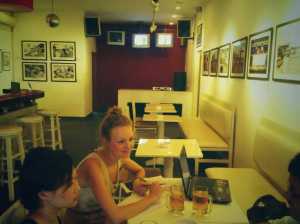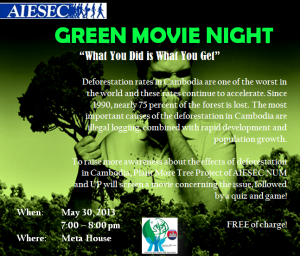 Mekong forest loss. Photograph: Graphic
Mekong forest loss. Photograph: GraphicGreen Movie Night pt. II
Green Movie Night has come and gone, and we emerged from all the complications and time restraints (relatively) unscathed. We definitely learnt from the experience, and understand a lot better steps to problem mitigation all event organizers inevitably have to face.
Even though it was a sizable audience, we are pretty sure many people did not get to see the short films we showed. For that purpose, here is a recap of the clips, found through the Internet.
Recap
The first four clips we showed were environmentally concerned advertisements, filmed by the Greenpeace foundation and other Green NGOs. This first one was focused on the dubious ethics of corporations such as Nestle, which require millions of gallons of Palm Oil obtained from deforestation to manufacture their products. Palm Oil is used in many industries, such as the food industry, cosmetics industry, Biodiesel, industrial applications, and many others. Indeed, global demand for the substance is astonishingly high, leading some to dub it “gold oil”. However, as the circle of life dictates, one man’s profit is another man’s (or animal’s) loss. This advertisement depicts this edict chillingly:
The next video continued in pretty much the same vein, making commentary against another multinational corporation called Unilever, which owns cosmetic brands amongst others like Dove, Lux and Sunsilk. In this one, the imagery varied a little further, moving from a stark juxtaposition of human life against animal death to a more nuanced and politicized view, depicting not only a senseless slaughter of animals but also the eviction and disruption of life for other people who live and depend on their forested lands. The little girl’s thousand yard stare pierces deep into the viewer’s very soul, forcing guilt and discomfort and an aversion of eyes. Very effective.
The next video is a collaboration between Greenpeace and the Forest Stewardship Council, and starring famous stars such as Ewan Mcgregor and David Attenborough. It shows a surburban white household cowering in fear as their house is demolished without their consent by chainsaws, and compare that to the horrors animals face everyday when their homes, ancient forests that take thousands of years to grow, are destroyed by logging companies.
The last short clip we showed was about African villagers who are increasingly caught in an ecological dilemma. Reap the profits of their fertile forests and risk killing their homes long term, or fight a battle they cannot win against deforestation and lose all hope of having a better life.
Here are a few more clips we could not afford to show due to time constraints!
Finally, we showed the main attraction. Green: the Film, is a film of moving images, with no dialogue; it uses a stark juxtaposition of music and images to make its meaning felt. There is a vague story arc focusing on a sick orang utan named Green, who was evicted from its home due to deforestation – accompanied by imagery of animals in the wilderness contrasted with scenes of massive deforestation, industrial factories and consumerism. A very powerful movie in its very message, but admittedly a little difficult to get into. It has a wonderful website, with lists of companies in various fields that engage in possibly unethical deforestation. Although the setting was on the forests of Indonesia, there is no doubt that this is a problem that extends beyond geopolitical boundaries, and concerns all of us. We all feel the effects of deforestation in global warming, increased prices of consumer goods, and agricultural complications.
After our showcase was another film done by filmmaker Allan Michaud. He has been living in Cambodia for over 10 years, and has a series of excellent films also about deforestation. Do check out his Youtube channel, as well as his blog articles over at his WordPress.
Finally, thank you for supporting our cause and together, we hope to educate more people about the environment and the benefits of preserving nature! Come check us out at our new Reddit page, and follow us on twitter @plantmoretreePR.
Phnom Penh’s best street food
According to CNN, Phnom Penh is one of the greatest street food cities. So don’t hesitate and try one of delicious Cambodian threats!
Phnom Penh

Cambodians like to snack throughout the day, so it’s no surprise their capitol is teeming with street-food choices.
Depending on what time it is, you’ll find scores of different types of street cuisine being sold by roving vendors or at stationary street stalls that cook on small charcoal grills.
The local markets are also a good source of Khmer snacks, particularly Central, Kandal and Orussei, as well as the streets around the city’s many schools and universities.
Breakfast time and early evenings are particularly busy, as hungry students flood the streets, looking for fried noodles, Cambodian sandwiches and sweet treats.
 A classic with a Cambodian twist.
A classic with a Cambodian twist.
1. Num pang
Baguettes are a lasting legacy of the French colonization of Cambodia — as in Vietnam, they are used for street-side sandwiches that are filled with a mixture of Eastern and Western ingredients.
In Phnom Penh the sandwiches are filled with pate, butter or homemade mayonnaise, spicy red chili paste, crunchy pickled green papaya and carrot and a type of pork bologna and served with soy sauce and fish sauce on the side.
Try it at: Outside Kandal Market, Street 5, Phnom Penh
 Breakfast that travels to you.
Breakfast that travels to you.
2. Nom banh chok
This popular breakfast food is often called the Cambodian national dish.
It’s usually sold by women carrying the ingredients in baskets hanging from a pole balanced on their shoulders.
The noodles are made from fermented rice and topped with aromatic green fish curry gravy, flavored with lemongrass, kaffir lime leaves and turmeric root. Fresh herbs, bean sprouts, banana flower and cucumber are added for a pleasant, refreshing crunch.
Try it at: Russian Market, Street 440, Phnom Penh
 Eat at your own risk.
Eat at your own risk.
3. Num plae ai
These yummy small, round rice dumplings are filled with liquid caramelized palm sugar and topped with fresh coconut shavings.
They’re sometimes called nom somlap pdey, or “dessert that kills your husband,” because the smooth, chewy texture makes num plae ai easy to choke on if you eat them too fast!
Try it at: Top of street 258 and Sisowath Quay, Phnom Penh
 Get in early.
Get in early.
4. Bai sach chrouk
Bai sach chrouk, or grilled pork with rice, is a simple and delicious breakfast food sold by numerous Phnom Penh street vendors, who usually sell out by 8:30 every morning.
Thinly sliced pork that’s been marinated in coconut milk or garlic is grilled slowly over warm coals.
It’s served over steamed rice, sometimes with a fried egg, a side of freshly pickled daikon radish and cucumber, and a dab of spicy chili paste.
Try it at: Kandal Market, Street 5, Phnom Penh
 Ask for the food and drink combo.
Ask for the food and drink combo.
5. Coconut water
Vendors walk around Phnom Penh with carts piled high with young, green coconuts. They slice the tops off to order so customers can drink the coconut water with a straw. Cambodians believe that coconut water is extremely healthy, and many locals try to drink a coconut every day.
Once you’re finished, you can ask the vendor to slice the coconut open so you can access the flesh inside.
Try it at: Sihanouk Boulevard and Street 51, Phnom Penh
 Made to order.
Made to order.
6. Fresh fruit
One of the simplest but most delicious street foods that Phnom Penh has to offer is fresh ripe fruit. Vendors sell juicy pineapple, papaya, dragonfruit, watermelon, guava and green mango out of glass cases.
When you order, they’ll offer to cut the fruit into bite-sized pieces, which are eaten with a wooden skewer, and sprinkle it with entirely unnecessary MSG, sugar and chili.
Try it at: Top of street 258 and Sisowath Quay, Phnom Penh
 Keeps the kids happy.
Keeps the kids happy.
7. Mi char
Fried noodles are popular with students looking for an afternoon snack once school lets out.
Most noodle sellers carry a few options in their cart — instant noodles from ramen packages, soft yellow egg noodles, or short, thick rice noodles.
They’re stir-fried in fish sauce and soy sauce with beef and greens, and usually a fried egg is added to the equation. Most Cambodians choose to eat mi char with mild, sweet chili sauce.
Try it at: Central Market, Street 53, Phnom Penh
 Origin unknown.
Origin unknown.
8. Kuy teav
You’ll find similar noodle soups in Vietnam and Thailand, but kuy teav is believed to have originated with Chinese immigrants in Cambodia.
Whatever its origins, the soup is a hearty breakfast made with pork or beef broth and thin rice noodles, and topped with fried shallots, green onions and crunchy bean sprouts. Sometimes the soup will also contains prawns, beef balls or pork liver and is served with red chili sauce with vinegar and sugar.
Try it at: Across from Pencil, Sisowath Quay, Phnom Penh
 Eat with beer.
Eat with beer.
9. Ngeav chamhoy
Cockles steamed with chilies, fragrant lemongrass, kaffir lime leaves and galangal are an enticing late-night snack sold street-side and by roving vendors pushing carts with portable steamers.
Ngeav is the Khmer word for a type of native clam known as the blood cockle due to its red color, caused by hemoglobin similar to that in human blood.
Ngeav chamhoy taste best accompanied by a spicy chili sauce and washed down with a cold beer.
Try it at: Street 13, Phnom Penh
 Things are bound to get messy.
Things are bound to get messy.
10. Num sang khya l’peou
This treat is as tasty as it is impressive. A pumpkin’s seeds are removed and then it’s filled with egg yolks, palm sugar and coconut milk. The top is put back on and the whole thing is steamed for half an hour.
When it’s done, it’s sliced to best show off the contrasting orange pumpkin flesh filled with smooth, creamy custard.
Try it at: Orussei Market, Street 182, Phnom Penh
source: http://travel.cnn.com/explorations/eat/asia-street-food-cities-612721
GREEN MOVIE NIGHT
Contact:
Doy Dararoth: dararoth.doy@aiesec.net, 069373586
Sok Lak: lak.sok@aiesec.net, 098868442
Natascha Schippers: natascha.groningen@gmail.com, 093232647
For more information about Meta House and the programme please visit: http://www.meta-house.com/
Shocking outcome showed by WWF Report
 Mekong forest loss. Photograph: Graphic
Mekong forest loss. Photograph: Graphic


